
Architectural Styles and Revivals: The Greek and Roman Revivals
(written by Dr. Les Crocker, UWL Emeritus Professor of Art History)
Classical is a term for something from the Greek or Roman worlds, often a mixture of both cultures. It's not really Greek nor is it pure Roman but a blending of the two. Neoclassical is, as the name says, the new classical. Not just a revival of what once was but the creation of new buildings using old elements. These two themes dominate the use of classical elements, using old buildings as prototypes to exactly copy or treating various elements from classical buildings as independent items and arranging them to suit contemporary taste. Of course the more generalized use has dominated, partly because few buildings from the ancient world satisfy our present use or needs. Greek temples make poor houses, or churches, or schools, or much of anything other than Greek temples.
Around 1750 a revolution began, not with guns and cannon but with archaeologists, art historians, linguists, literary critics, and various other groups. They began to examine the past in an organized fashion.
Germany led the way in many aspects of the revolution, followed by England and France. There were, of course, other outbreaks of “reason” in various places. As we move away from 1750 those outbreaks became more widespread. In the American colonies, Benjamin Franklin represents one of those singular individuals that worked and thought in new ways. It is interesting that Franklin began life as a printer for it was the printing press that spured this cultural revolution.
It was as if Europe suddenly realized that it had a past and its past also had a past. After all, many wealthy young men from Germany, England and France were touring the remains of the Roman empire in Italy and their own countries. Roman temples still stood throughout Europe, although mostly incorporated into other buildings or made into churches. Roman and Greek writers were well known to the educated minority and many of the wealthy read latin and greek. For those who did not read the ancient languages in the original there were multiple English, German, and French versions of the ancients, many in pocket sized editions. Even in the American colonies there are records of men who began their day reading passeges from Vitruvius or Plato.
The printing press allowed inexpensive multiples to be made and shared. Franklin regularly wrote to many men, and a few women, in Europe and the colonies sharing new information. Everyone seems to be writing letters saying “Have you read this?” or “ James found a date scratched into the wall of that old temple,” or “Lord Fred has come back from Rome with a shipload of sculptures.”

The Parthenon in Athens from 440 BCE and the Pantheon in Rome from 126 CE were the most widely reproduced buildings from the ancient world and thus were the best known to people in La Crosse. Pictured here is the Nashville Parthenon, a replica of the original built in 1897 for the Tennessee Centennial Exposition. Also pictured, the actual Pantheon in Rome.
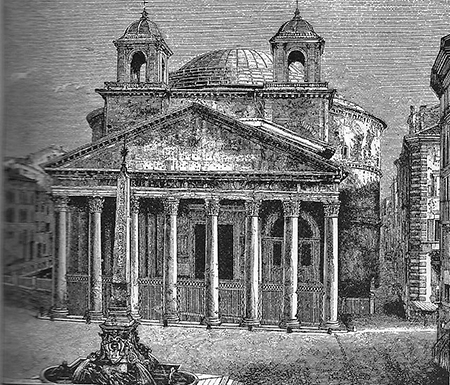
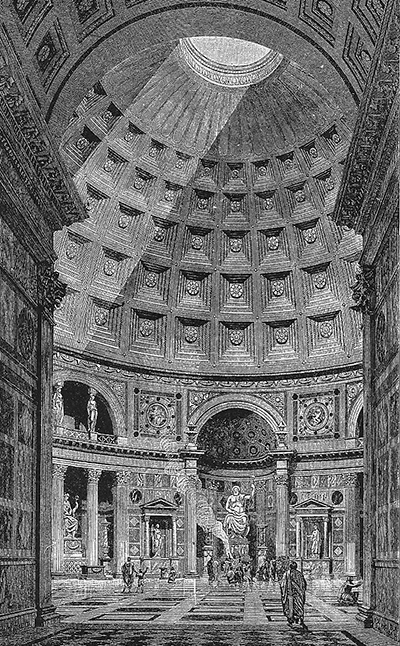
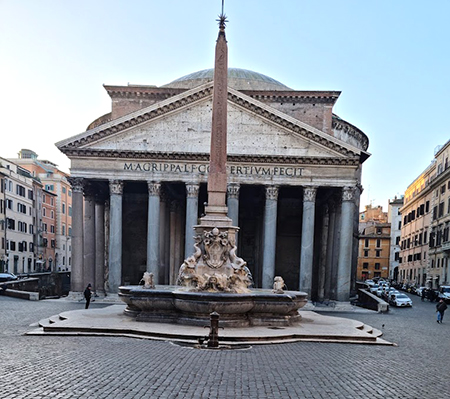
Engravings and a more recent photo of the Pantheon in Rome.
This mass of unconnected information gradually got sifted down and became ORGANIZED. Lists of rulers in England, Germany, and France were established, providing an organized framework that other events could be hung on. The idea of “History” developed and branched into political history, military history, natural history, art history, music history, and all the others. At the same time the 'ologies' developed. This corrupt use of Latin came to mean 'the study of whatever.' Thus we have biology, the study of the living world; geology, the study of the physical structure of the world; mineralogy, the study of the minerals of the earth and the eventual definition of the various elements that make up the earth; and the like.
In many ways this fascination with the ancient Romans and Greeks was just a continuation of the what had begun in the Italian Renaissance with translations of Greek and Roman manuscripts.
The Past became a place where almost anything could have happened. There were hundreds of popular books written after 1750. Romantic novels, some really trashy and almost unreadable today, fought for popularity. Fashions, especially in women's clothing, imitated those found on ancients statues. Hair styles were like wise taken from the past. At least one cookbook from ancient Rome survived the ages and influenced late eighteenth century contributions to the total understanding of what had gone on in the past.
Classical Houses
By the time La Crosse was settled the classical revivals were declining in popularity. The Bentley-Edwards house at 821 King St. is our only surviving temple-type classical house, although there are a few classical elements on other houses.
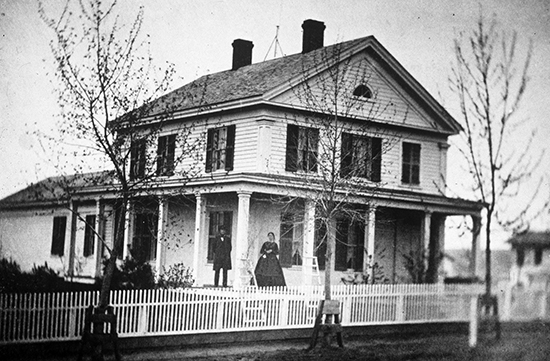
The house turns its narrow end toward the street and makes the gable roof a pediment by the addition of a horizontal cornice linking the diagonals of the roof.

The later screened porch hides that detail so most of the classical elements cannot be seen today. The porch columns are square instead of the round form used in the ancient world but have nicely detailed capitals and recessed panels on the shafts. The porch originally covered the south and west sides of the house where shade from the sun would be most needed.
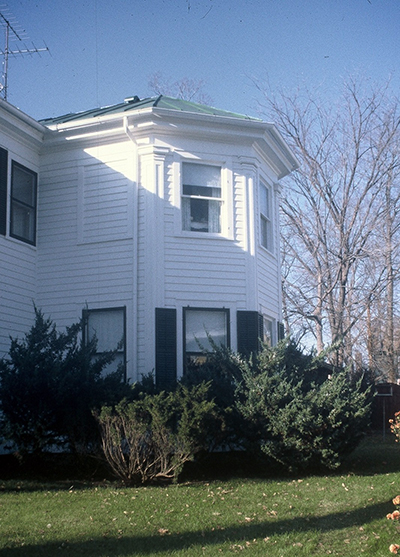
The corner pilasters that show on the old photo cannot be seen very well today but are repeated on the two story bay on the east side that was a later addition. 1981 photo by author.
The so-called Greek Revival house, now owned by the Preservation Alliance of La Crosse (PAL) and located behind the Hixon house at 426 N. 6th Street, shows the limited approach to a classical front in a very early La Crosse house that was later moved to the rear of the property and made into a garage.

The Greek Revival house today. It had cornice returns as well as a simple entablature supported by pilasters at the entrance. 2010 photo by author.

A photo of the house before it was moved, when it functioned as a garage.
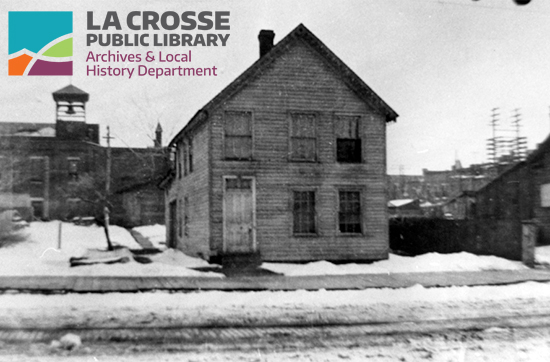
The Milton and L.J. Barlow house 120 N. 4th Street, 1856, now demolished, is almost an exact copy of the Greek Revival house and there were.dozens of similar houses in Early La Crosse. Their only claim to Greek Revival fame is having the gable end turned toward the street as if it were a pediment. Unlike the Greek Revival house it has no decorations of any sort, few houses did in the very early years.

The J. Burnett house, formerly at 410 S. 3rd Street, now demolished, built in 1851 was spoken of quite highly by older residents when I first came to La Crosse in 1969 but what I saw did not live up to the reputation. By then the house had obviously been altered several times over the years and the remaining building was not spectacular.
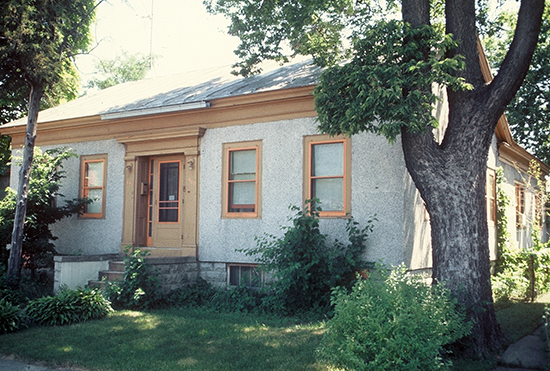
The recessed entrance at William Harrison‘s house at 603 S. 4th Street, built in 1866 has two simple pilasters that support an entablature; it was quite elegant for the time even though the remainder of the house is quite plain. 1976 photo by author.
Classical Public Buildings
Public buildings in the United States often use the Classical style. Washington, D.C. and many state capitals are full of them. It is the unofficial style of government buildings. La Crosse had neither a neoclassical city, nor county, building. Most of the public buildings have been Romanesque Revival, because that was the popular style when they were built during the boom years of 1870-1890. More on that in the upcoming blog on the Romanesque Revival.
Classical Commercial Buildings
Neither the Greeks, nor the Romans had banks as we know them, but the U.S. once had lots of neoclassical banks with columns and a pediment on the front. The rectangular Greek temple might seem a good source of inspiration for a bank building, but the original forms were generally windowless, set above the general public space, with the interior space left open; so a Greek temple isn't a very good prototype for anything for modern use. In most cases the classical world is represented by two or four columns visually supporting a triangular pediment. That's it, those two elements, columns and pediment, pretty much constitute the Roman revival, Greek revival, and the use of neoclassical elements in commercial buildings.
La Crosse once had several neoclassical banks.
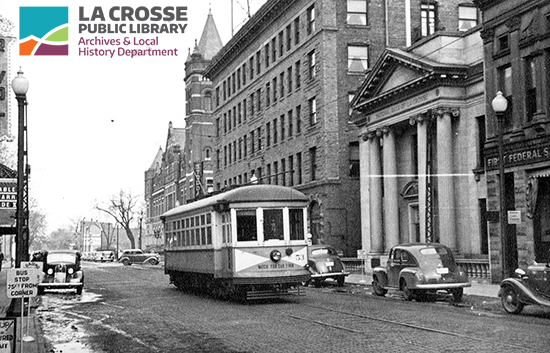
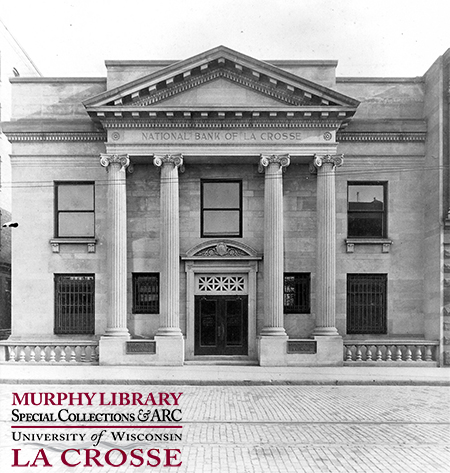

The National Bank at 120 N. 4th Street was a great example of the neoclassical banks that existed all over the Midwest from the Civil War until the 1950s. The neoclassical represented ages past, continuity, security. A view of the interior from a postcard shows the classical theme continued throughout the bank.
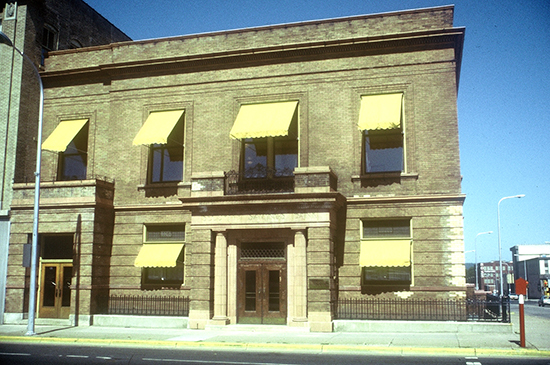
The Security Savings Bank at 125 N. 4th Street is the only surviving bank building with neoclassical elements. 1985 photo by author.

On the east side of the building, two Roman doric columns flank the entrance to an otherwise rather plain facade. 2023 photo by author.

However, the north side has a more elaborate neoclassical section with double doors. 2023 photo by author.
Classical Religious Buildings
There were no Christian churches in the Greek or Roman worlds until late in the third century, CE. When the Christians begin to build large structures they copied what they knew. The basilica was a rectangular Roman building, usually divided into three aisles running the length of the building, a main center aisle flanked by a smaller aisle on each side. This plan was used by the early Christians because it was a good method to organize interior space and is still used in many Christian churches, regardless of style or time period. So in a sense any building with three aisles is a classical revival, or perhaps classical survival, since the design has been in continuous use for over two thousand years.
The three entrances on the front of many Christian churches are taken from the various Roman triumphal arches. The Christian interpretation being the triumphal entry into the heavenly kingdom since christian doctrine during most of the Middle Ages stated that the church interior was a part of heaven but on earth. Again, either the triumphal arch motif is a survival or a revival of Roman designs. A strong argument can be made for either case.
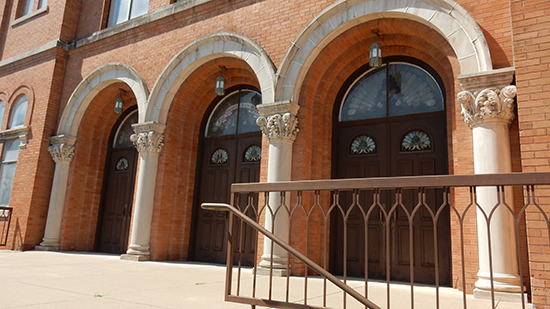
Triumphal archways mark the entrance to the First Evangelical Church on the corner of West & Cameron Streets. 2023 photo by author.
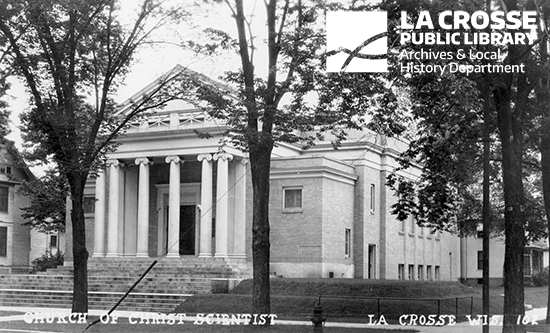
The First Christian Science chuch at 145 West Ave. is the most "Roman" of all the religious buildings in La Crosse. The six columns across the front of a porch with a pediment on the building behind is typical of a late-Roman style popular in the third century, especially in the eastern regions of the empire. The building is now home to the La Crosse County Historical Society.

St. John's Reformed Church, West Ave. at Market Street is not Greek or Roman, but English Renaissance. Some people consider anything with columns to be Greek, but not so; many of the churches that use columns and pediments are the revival/survival of the English Renaissance. Sir Christopher Wren built a number of churches in London after the Great Fire in 1666. The anglican churches, in their various manifestations, often used the style, making them sort of the grandchilderen of the Classical world. 2023 photo by author.
The Losey Memorial monument at the entrance to Oak Grove Cemetery was dedicated in 1902, one thousand five hundred and eighty seven years after its ancestor was dedicated in Rome. For me, it is the most dramatic indicator of the enduring influence of the Roman world.
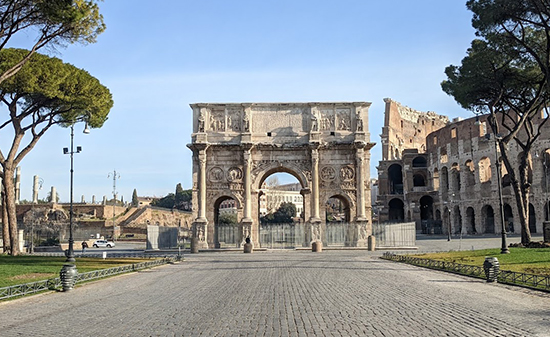
The Arch of Constantine in Rome.
"Gentlemen, you did well to select that arch as a memorial to Joseph W. Losey. It is typical of the man. 'Tis the elemental figure upon which the great science of architecture is founded and from which it is named. It is independent. It is graceful and strong. Not only self-supporting but able to bear the burden placed upon it."
-From the dedication speech by La Crosse attorney C. L. Hood, May 31, 1902
This is not great philosophy, but a friend of Losey comparing him to one of the three basic forms in architecture: post and lintel, arch, and triangle. Some would include the sphere or half sphere but very few cultures used them in building so they weren't relevant to Hood's point.
Let's think about this a little bit. Oak Grove Cemetery was an old burial ground, once on the edge of La Crosse. Many of La Crosse's most famous families are buried there. The operation of the cemetery was overseen by board members of the association that owned the land. In the nineteenth century, cemeteries were often the only open ground available to the common people. Tree shaded walks and lanes gave views of natural scenery as well as monuments to the dead.
So, how do you honor a man important to the community as well as the cemetery association? They wanted a public memorial, to be built at the most significant entrance to the cemetery on a significant road connecting what would become Losey Boulevard with West Avenue and the road north across the marsh. They chose the Arch of Constantine, dedicated to perhaps the greatest Roman emperor. Constantine made Christianity a legal religion in the empire, so he combines the Roman with the Christian. In later centuries, many Christian churches used the three arched opening as their entrance and a reflection of the Trinity.
The intertwined history of Rome and Christianity is mixed with civic pride and nineteenth century ideas of natural beauty. The ideas of the ancient world had continued, or been rediscovered, and the educated men of the period had great respect for them.

The Losey Memorial at Oak Grove Cemetery. The plaques above the west and east portals read respectively: "He found this cemetery neglected and desolate. He transformed it into a place of charm and beauty. He made the wilderness to blossom as the rose." and "To commemorate the character and virtues of one who endeared himself to all by an unbroken record of private charities and unselfish public services, this memorial is erected by citizens of La Crosse, A.D. 1901." 2023 photo by author.
Other entries in this series
Architectural Styles and Revivals
Architectural Styles and Revivals: The Gothic Revival
Architectural Styles and Revivals: The Exotic Revival
Architectural Styles and Revivals: The Italianate Style
Architectural Styles and Revivals: The Second Empire Style
Architectural Styles and Revivals: The Queen Anne Style
Architectural Styles and Revivals: The Colonial Revival
Architectural Styles and Revivals: Romanesque Revival Public Buildings
Architectural Styles and Revivals: Romanesque Revival Commercial Buildings
Architectural Styles and Revivals: Romanesque Revival Homes
Architectural Styles and Revivals: Religious Romanesque
